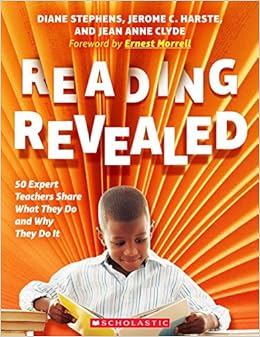This summer we were given the opportunity to read Reading Revealed by Diane Stephens, Jerome C. Harste, and Jean Anne Clyde.
If you're a new teacher in need of ideas for reading OR if you're looking for a book to refresh your reading instruction, this the one for you. This book is jam packed with lessons and ideas to get to know your readers intimately.
When reading this book, you will start with a refresher on knowing reading. It's important to know reading so you can know your reader. Once you know your readers, and what they are and are not paying attention to, you can customize your instruction based on student strengths and needs. Also, this book shares links and reproducibles that you can use in your classroom! BONUS!
In Part 1, Tim O'Keefe gets into what teaching reading requires. As a writing teacher, I'm thankful for my colleagues and what they do to teach our young firsties about how to read and reading. As a reading teacher you have to do a lot to know your readers. O'Keefe begins by talking about Kidwatching. Noticing and recording what you see helps you to pay attention to what is important and relevant to your students. Next, O'Keefe discusses conferences, written conversations, independent reading, reading logs, and responsive teaching. All of these sections highlighted his depth of knowledge for reading. I was intrigued by the written conversations and wonder if this is something that could be done with first graders. I could definitely see its use in older grades as the students are more confident as writers. He also shares his Responsive Teaching Cycle. It's definitely something I can see myself using in my classroom.
Next, in Part 2, many authors contributed to lessons on Knowing Readers. These lessons start with an activity called Shoebox Autobiographies by Jean Anne Clyde. This lesson helps you to really get to know your students. You can include anything in these boxes, but Jean Anne says it should contain one literacy-related item, personal artifacts, and maybe a sketch. The sketch is so students who can't bring a picture, know they can always draw it! :)
The chapter goes on to give many other ideas for lessons, again all aimed at getting to know your readers. There are lessons on Running Records, Formal Miscue Analysis, and a Hypothesis-Test Process.
And then there is Part 3...Engaging Readers. As I started this section, I was reminded of a quote from Steven Layne's book, Igniting a Passion For Reading:
I think there are different opinions on this. What comes first, the skill of reading or the desire and will to read? As a teacher of younger students, I am certainly working on both but my goal is always to leave my students with a desire to want more books! My hope is that as they transition from learning to read into reading to learn...they want to utilize this skill!
25 different strategies to engage readers are described within this section. Each author gives you potential language to use when introducing the strategy to students. This can be particularly helpful when trying out something new, as the facilitator. Videos of a classroom in action are even included.
So what stood out to me? Toy Stories. With this strategy, students use dolls or action figures to tell stories. This supports oral language, story telling, character development, and details. All of this can then transfer into writing. This is a strategy we have been discussing over the past couple of years because we watched these skill develop in our own children through role playing. Legos, mud and flowers, figures, stuffed animals...stories can be built in many ways!
The last section of Reading Revealed is about the language we use with students. One of the most powerful things we can do with our readers (in my personal opinion) is to TALK to them! Discussing books, being interested in their opinions about books, and respecting their book choices requires us to pay attention to the language we use as educators. Reading mini lessons and instructional conversations are the two strategies that the author focuses on in this section.
Diane Stephens opens the introduction of this book with one powerful sentence.
This book is based on the premise that no matter how long we have been teaching, no matter how good we are as teachers, we can always do a better job tomorrow than we did today.Out of every book we read, we can find a nugget (or many) that helps us to support our students. If you need some new "nuggets" or you know a new teacher that could use some guidance in reading, then enter the GIVEAWAY below to win your own copy of this book.

a Rafflecopter giveaway



No comments:
Post a Comment
We love to hear from you! We will reply through email or in a comment above. Thank you!!